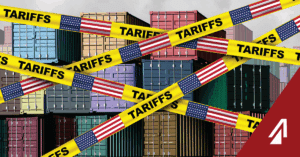One of today’s largest cost-increasing issues for companies is supply chain disruption. Each year, companies pay millions of dollars in fees for problems like order issues, delays, or stock outs. Then, each issue can have a ripple effect echoing throughout the entire supply chain – multiplying your costs. A common solution to this problem is to increase inventory, storage locations for safety stock, or your number of suppliers. However, none of these solutions can help you be more cost efficient.
Modern companies are turning to technology to help with this problem. Supply chain visibility tools are an effective, cost efficient way to reduce supply chain disruptions and save companies money.
Why is Supply Chain Visibility Important
Most companies today collaborate on their supply chain with countless other companies. Each product is made of multi-supplier components and that are shipped across a vast, complex network. With that collaboration, either from outsourcing or by the nature of a multi-tiered system, your company can lose control of your inventory and limit your decision making. Supply chain visibility allows you to regain control by knowing where your inventory is at any time and help you optimize your decision making. In that way, you can both plan ahead for – and react swiftly to disruptions. So, how does it work?
Gets Stakeholders on the Same Page
Supply chain visibility allows information to flow across the entire supply chain network so that each stakeholder can see the chain in whole. In the past, companies would silo information, usually unintentionally, and limit what the rest of the chain could do. Those limitations cause delays and inefficiencies that cost money.
Today, supply chain visibility tools capture information across the entire supply chain and allow stakeholders to make informed decisions based on data. Each facet of the supply chain can use this data to better plan their operations. Customers can input orders, and vendors and carriers can plan shipments based on those orders. Carriers can plan upcoming shipments and not scramble to find freight. Customers can track their freight in real-time; that offers them better service and allows them to better serve their own customers.
Helps Reduce Costs and Increase Sales
According to the 2018 BCI Supply Chain Resilience Report, 62% of companies experience significant financial losses due supply chain disruptions. Of those surveyed, 14% of companies lost over €1 million ($1.09 million) from disruptions. Having supply chain visibility can greatly impact those losses.
Supply chain visibility can close the disruptive gaps in your supply chain and help you save on costs. Hard data, from SCV, can offer transparency in your operations and present savings in areas like:
• Improved supplier performance
• Continuous improvement initiatives
• Reduced storage and inventory costs
• Lean management/JIT shipping opportunities
• Reduced expedites or specialized options
• Reduced assessorial charges
• Reduced stockout scenarios
Most companies realize that their supply chain is a cost-center, and that being able to reduce these costs is a driving factor for growth and increased spending. This increased spending translates to sales. The more you can save your customer in areas like shipping, the more they are able to spend on products or services. Eye for Transport (EFT) produced a 2018 study that shows cutting supply chain costs is one of the greatest factors driving increased spending. SCV can help with that.
Supply Chain Complexity
Supply chains have been incredibly complex from the beginning of time; but now, with greater demand for more immediate delivery, the pressure is higher than ever. Most products travel through multi-tiered systems before reaching the ultimate customer. Any delay can cause major disruptions down the line, but most companies do not, or cannot, trace the source of their disruption past their immediate supplier. Utilizing supply chain visibility can help with this.
SCV technology can track data from a product’s source. Tools like blockchain can be used to securely log the data so that each stakeholder can have access to it. In a previous blog we discussed how blockchain can help. That blog said “Blockchains can be used to verify information like locations, dates, times, and product codes. Users can have exact time/date stamps available as well as location. Each party would have exact evidence to prove a shipment delivered at a particular time or that a product originated from where the shipper said it did.” That information is critical to sourcing where delays occur and providing you with the knowledge you need to optimize your supply chain.
Visibility is important, and we provide our clients full supply chain visibility: LET’S TALK ABOUT YOUR VISIBILITY NEEDS
Supply Chain Visibility Tools
Technology has become one of the most valuable tools in achieving greater supply chain visibility. Whether in the physical or digital space, these tools work together in a complex network of data capture devices, cloud networks, and interpretation software to help streamline data creation and storage and ease stakeholder decision making. They help create deeper user insights, faster response times, and stronger, more reliable data connections than ever before.
Many modern supply chain visibility tools are physical objects that can help track or capture data for users. Some of the most popular, and rapidly advancing tools are IoT devices. These are any device that can connect to the internet to send or receive data. Devices like cell phones are invaluable for GPS tracking as well as making calls or accessing applications. These work in concert with other GPS devices to help provide stakeholders real-time updates. Other popular tools like RFID or UPC scanners and trackers help users to pinpoint product locations inside the warehouse as well as over-the-road. These tools can help with inventory and warehouse management as well.
Digital visibility tools are growing increasingly fast as well. More companies are using digital control towers made up of numerous software packages to track and maintain their supply chains digitally. Programs like TMSs are used to store the captured data and utilize cognitive analysis technology like A.I., machine learning, and self-learning systems to help process it. They can help plan and manage current shipments as well as review and audit historic ones. Also, they act as a centralized hub for various members of the supply chain to interact with one another.
Other ERP systems like WMS or other legacy systems, coupled with newer VFISs, can help you manage internal operations like warehousing or production facilities. Tools like blockchain are up and coming and can help with data security and reliability.
Supply chain disruptions are incredibly costly to your company’s bottom line, but supply chain visibility tools can help you combat them. Using sophisticated technology can help you see supply chain weaknesses and give you the control to make decisions and correct them. This helps reduce costs and boost sales. Currently, only 6% of companies report having full supply chain visibility and as much as 62% report only limited visibility. Companies need to take advantage of these tools to improve their visibility and reduce supply chain disruptions.
We can provide the tools needed for your full supply chain visibility: LEARN MORE



